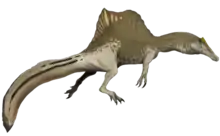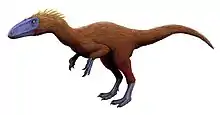Deinodon
Deinodon (Greek for "terrible tooth") is a dubious tyrannosaurid dinosaur genus containing a single species, Deinodon horridus. D. horridus is known only from a set of teeth found in the Late Cretaceous Judith River Formation of Montana and named by paleontologist Joseph Leidy in 1856.[1] These were the first tyrannosaurid remains to be described and had been collected by Ferdinand Vandeveer Hayden.[1] The teeth of Deinodon were slightly heterodont, and the holotype of Aublysodon can probably be assigned to Deinodon.[2]
| Deinodon | |
|---|---|
 | |
| Illustration of the teeth | |
| Scientific classification | |
| Kingdom: | Animalia |
| Phylum: | Chordata |
| Clade: | Dinosauria |
| Clade: | Saurischia |
| Clade: | Theropoda |
| Family: | †Tyrannosauridae |
| Subfamily: | †Deinodontinae Cope, 1866 |
| Genus: | †Deinodon Leidy, 1856 |
| Type species | |
| †Deinodon horridus Leidy, 1856 | |
| Synonyms | |
| |
History and classification
It is likely that the fossilized teeth of D. horridus belonged to the dinosaur later identified as Gorgosaurus libratus. In a 1922 study, William Diller Matthew & Barnum Brown found that the teeth of D. horridus and G. libratus were indistinguishable from each other, and that they almost certainly belonged to the same species. However, because D. horridus was not yet known from any skeletal remains, they refrained from formally declaring them to be synonyms.[3][4] In a 1970 review, Dale Russell stated that because the teeth of D. horridus could not be distinguished from either G. libratus or his newly described species Daspletosaurus torosus, it must be considered a nomen vanum ("empty name").[5] Since Russell published his opinion, most researchers have regarded Deinodon as a nomen dubium,[4] though some have argued that since Deinodon and Gorgosaurus cannot be distinguished, they should be synonymized with D. horridus as the valid name for "Gorgosaurus" skeletons.[6] Additionally, several researchers have agreed that the genus Aublysodon (including the species A. mirandus and A. lateralis), should also be considered a synonym of Deinodon, since it is based on incisor teeth that likely come from the same animal.[2][3][6] Lambe (1902) went further, and said that as originally named, Deinodon was not preoccupied, and instead, regarded Aublysodon as a nomen nudum.[2]
Description
Deinodon is known from a few, slightly heterodont teeth.[2]
A few phalanges, and a metatarsal with fragments of others, were found to be possibly assignable to D. horridus by Lambe in 1902.[2]
List of species and synonyms
Numerous species were referred to the genus Deinodon in the past. However, because most researchers now consider the genus and its type species nomina dubia, any additional species referred to the genus cannot be supported.
| Name | Author | Year | Combination author | Combination year | Status | Notes |
|---|---|---|---|---|---|---|
| Deinodon horridus | Leidy | 1856 | Leidy | 1856 | Nomen dubium, type species | |
| Deinodon explanatus | Cope | 1876 | Lambe | 1902 | Reclassified as Dromaeosaurus explanatus nomen dubium | Originally Laelaps explanatus |
| Deinodon falculus | Cope | 1876 | Osborn | 1902 | Reclassified as Dromaeosaurus falculus nomen dubium | Originally Laelaps falculus |
| Deinodon incrassatus | Cope | 1876 | Osborn | 1902 | Nomen dubium | Originally Laelaps incrassatus |
| Deinodon lateralis | Cope | 1876 | Hay | 1902 | Synonym of Deinodon horridus | Originally Aublysodon lateralis |
| Deinodon cristatus | Cope | 1877 | Osborn | 1902 | Synonym of Troodon formosus | Originally Laelaps cristatus |
| Deinodon hazenianus | Cope | 1877 | Osborn | 1902 | Nomen dubium | Originally Laelaps hazenianus |
| Deinodon laevifrons | Cope | 1877 | Osborn | 1902 | Reclassified as Dromaeosaurus laevifrons | Originally Laelaps laevifrons |
| Deinodon amplus | Marsh | 1892 | Hay | 1902 | Reclassified as Aublysodon amplus | Originally Aublysodon amplus |
| Deinodon cristatus | Marsh | 1892 | Hay | 1902 | Reclassified as Aublysodon cristatus | Originally Aublysodon cristatus |
| Deinodon grandis | Marsh | 1890 | Osborn | 1916 | Synonym of Deinodon horridus | Originally Ornithomimus grandis |
| Deinodon sarcophagus | Osborn | 1905 | Matthew & Brown | 1922 | Reclassified as Albertosaurus sarcophagus | Originally Albertosaurus sarcophagus |
| Deinodon libratus | Lambe | 1914 | Matthew & Brown | 1922 | Synonym of Gorgosaurus libratus | Originally Gorgosaurus libratus |
| Deinodon arctunguis | Parks | 1928 | Kuhn | 1939 | Synonym of Albertosaurus sarcophagus | Originally Albertosaurus arctunguis |
| Deinodon novojilovi | Maleev | 1955 | Maleev | 1964 | Synonym of Tarbosaurus bataar | Originally Gorgosaurus novojilovi |
| Deinodon sternbergi | Matthew & Brown | 1923 | Kuhn | 1965 | Synonym of Gorgosaurus libratus | Originally Gorgosaurus sternbergi |
| Deinodon periculosus | Riabinin | 1930 | Kuhn | 1965 | Synonym of Tarbosaurus periculosus | Originally Albertosaurus periculosus |
| Deinodon lancensis | Gilmore | 1946 | Kuhn | 1965 | Reclassified as Nanotyrannus lancensis | Originally Gorgosaurus lancensis |
| Deinodon lancinator | Maleev | 1955 | Kuhn | 1965 | Synonym of Tarbosaurus bataar | Originally Gorgosaurus lancinator |
| Deinodon kenabekides | Hay | 1899 | Olshevsky | 1995 | Synonym of Deinodon horridus | Originally Dryptosaurus kenabekides |
See also
References
- Leidy, J. (1856). "Notices of the remains of extinct reptiles and fishes, discovered by Dr. F.V. Hayden in the badlands of the Judith River, Nebraska Territory." Proc. Acad. Nat. Sci., 8(2): 72.
- Lambe, L. (1902). "On Vertebrata of the Mid-Cretaceous of the North West Territory". 3 (4). Contributions to Canadian Palaeontology: 49. doi:10.5962/bhl.title.61817. Cite journal requires
|journal=(help) - Matthew, W.D. and Brown, B. (1922). "The family Deinodontidae, with notice of a new genus from the Cretaceous of Alberta." Bulletin of the American Museum of Natural History, 46(6): 367-385.
- Carr, T. D. (1999). "Craniofacial ontogeny in Tyrannosauridae (Dinosauria, Coelurosauria)". Journal of Vertebrate Paleontology. 19 (3): 497–520. doi:10.1080/02724634.1999.10011161.
- Russell, D. (1970). "Tyrannosaurs from the Late Cretaceous of western Canada." National Museum of Natural Science Publications in Palaeontology, 1: 1–34.
- Sahni, A. (1972). "The vertebrate fauna of the Judith River Formation, Montana." Bulletin of the AMNH, 147(6).













